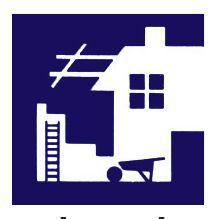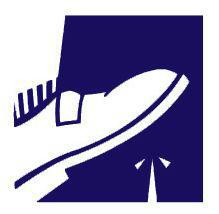SAS Urban Survival Handbook (27 page)
Read SAS Urban Survival Handbook Online
Authors: John Wiseman
Tags: #Health & Fitness, #Reference, #Survival, #Fiction, #Safety, #Self-Help, #Personal & Practical Guides, #General, #Survival Skills

In Britain a licence is needed to keep a poisonous snake, but a tarantula or a boa constrictor can be kept without infringing the law. However, it is obvious that they must be housed so that they cannot roam free or pose any risk to others. Owners must know how to handle them and the animals may come to recognize such handling. DO NOT encourage visitors to handle them without supervision and instruction—you could be held responsible if any mishap occurred.
DIY/craft hazards
More and more DIY tools and products are appearing on the market—statistics indicate that do-it-yourself is increasing likely to become a case of do-it-TO-yourself! Knowing the risks should help you to avoid serious injury.
USING TOOLS
BASIC TOOLS
Hammers/mallets • Screwdrivers • Chisels • Awls • Saws • Files • Knives
POWER TOOLS
Drills • Sanders • Saws • Power planers • Electric screwdrivers • Angle grinders
• Wood dust
HIRE TOOLS
General safety • Chainsaws • Soldering/brazing • Welding
PAINT
Emulsion • Gloss • Primers • Stripping
CRAFTS
Photography • Ceramics • Enamelling • Stained glass • Artists’ paints
LADDERS
Platform towers
PROTECTIVE CLOTHING
DOING IT YOURSELF
 There is a growing interest and participation in ‘having a go’ at home improvements of one sort or another. The number of possible dangers is very high—depending on each individual’s level of skill, the complexity of tasks undertaken and the levels of risk involved for the amateur.
There is a growing interest and participation in ‘having a go’ at home improvements of one sort or another. The number of possible dangers is very high—depending on each individual’s level of skill, the complexity of tasks undertaken and the levels of risk involved for the amateur.
Some people will never lift a screwdriver in their lives, others will attempt to build extensions to their homes—or complete new homes.
Most common injuries
In Britain alone this ‘have a go’ enthusiasm results in an estimated 120,000 casualties a year. Cuts to the hands and fingers from knives, saws, screwdrivers and chisels are the most common injuries—accounting for almost a quarter of the total. An enormous number of injuries are caused by nails, screws and tacks!
Falls from tripping over cables and dust sheets or falling downstairs, falling off stools/chairs/trestles/boxes account for almost as many casualties. Careless or casual use of ladders and stepladders results in some very serious falls.
Less common—but still far TOO common—(in decreasing order of frequency) is the number of people who hit themselves with hammers, injure themselves with power tools and get things in their eyes, sometimes dust and sometimes major debris.
Why do it yourself?
Most people who have been injured while indulging in do-ityourself—even only at the hobby level—give the same answers. The factors that seem to drive the enthusiasts on are quite understandable:
- ◑ It is difficult to find reliable professional workers.
- ◑ The cost of using professionals may be prohibitive.
- ◑ Thousands of DIY products are available.
- ◑ Hundreds of handy ‘gadgets’ are available.
- ◑ There’s a thrill to learning a new process.
- ◑ There is great satisfaction in a job well done.
It’s very true that today’s paints and wallpapers are better made and easier to apply. Kit-form furniture is common, but even without it there are lots of fittings and gadgets around which have made traditional joinery unnecessary for the amateur. But easier doesn’t mean SAFER.
Danger factors
Many home improvers learn the hard way, practising new skills with each job they undertake. Inadequate safety precautions, not reading safety instructions with tools, the lack of safety instructions with traditional tools and an incomplete grasp of the dangers involved are a frightening combination.
Add to these the fact that new tools, equipment and substances are introduced into the market on a regular basis—and there has to be a first time for every individual with each tool or process, however generally experienced the individual.
ALWAYS ask suppliers or even manufacturers for advice. ALWAYS read the safety instructions. Approach each new job with CAUTION, considering possible hazards.
SAFETY CHECKLIST
Many injuries are caused by:
- ■
Incorrect use of tools and power tools - ■
Not using/not buying protective guards for power tools - ■
Not using/not buying dust and debris collectors, which are attached directly to power tools or enable a vacuum cleaner to be connected - ■
Lack of maintenance of power tools - ■
Incorrect use of hire tools or inadequate safety briefings - ■
Underestimating the strength required to operate some hire tools - ■
Lack of precautions against/understanding of electrocution - ■
Lack of protection: eyes, ears, nose, lungs, hands, feet, limbs, head - ■
Inadequate lighting while working - ■
Slippery or uneven floors, or carelessness with dust sheets - ■
Lack of fire precautions - ■
Inadequate ventilation - ■
Incorrect use of ladders/scaffolding/improvised ladders - ■
Misuse or misunderstanding of chemicals - ■
Incorrect storage of chemicals and equipment - ■
Lifting/carrying too heavy a load or lifting incorrectly - ■
Lack of care with glass - ■
Rushing to complete laborious tasks - ■
Not supporting or anchoring workpiece
REMEMBER
Always work on a firm surface. A collapsible/portable workbench is a good idea—especially with adjustable grips to hold your work steady.

WARNING
Walls, floors and ceilings conceal electric cables and pipes carrying water and gas. Take great care when nailing, screwing or drilling. Use a battery-operated detector to avoid nasty accidents. Piercing a live cable could be FATAL (see SAFETY FIRST: Electrocution).
USING TOOLS
 It is not possible to give safety guidelines to cover every do-it-yourself process, nor is this intended to be a do-it-yourself manual. The information about basic tools is intended to assist the inexperienced worker, to help prevent accidents. The prime concern is not to focus on correct DIY techniques, nor to avoid damage to a piece of work (perhaps from a slip with a screwdriver), but to try to ensure the safety of the user of the tool.
It is not possible to give safety guidelines to cover every do-it-yourself process, nor is this intended to be a do-it-yourself manual. The information about basic tools is intended to assist the inexperienced worker, to help prevent accidents. The prime concern is not to focus on correct DIY techniques, nor to avoid damage to a piece of work (perhaps from a slip with a screwdriver), but to try to ensure the safety of the user of the tool.
Experienced handypersons may find some of the information a little obvious, but should still benefit from a few reminders on safety!
The work area
DON’T leave tools lying around. Try to be methodical about putting them away. A toolbox or special cupboard will do, if you don’t fancy the idea of special racks. Put protective covers on (if you have them), especially on piercing tools like bradawls—a cork would do, jammed on the end—and knives and chisels. If knife blades are removable, discard them at the end of working. You’ll probably want a new blade next time you use the knife.
Try to be tidy. You’ll find things more easily, lower the injury risk of searching through piles of tools or tripping over them and make your tools last longer.
The floor
Keep floors as clear as you can, especially the immediate area where you expect to be working. Keep dust sheets flat and make sure they don’t slip on the floor below. Don’t leave flexes and extension cables trailing about. If you spill any liquids, mop them up at once.
Lighting
Keep the area well lit, with natural light when possible. Supplement this with inspection lights, spotlights or domestic lighting, bearing in mind the possibilities of electrocution and fire. If fixing permanent work-area lighting, consider low-voltage options. Fixed appliances could have their own separate illumination nearby. Don’t work in your shadow!
Ventilation
Ventilation is
vitally
important in several ways. You must NOT expose yourself or others to clouds of dust or fumes while working. Dust is a long-term health hazard and breathing protection should be worn. Damp the floor before sweeping up, or use a mop. DON’T sweep the dust when dry, you will only recirculate it—and DON’T use a domestic vacuum cleaner. Vacuum cleaners trap larger particles of dust, but smaller ones can pass straight through the machine and become airborne again. If you have a permanent work area, investing in an extractor fan would be a good idea.
Fumes also pose severe health risks. The fumes of some substances may be carcinogenic (cancer-causing) in the long term—in the short term they may make you drowsy and incapable of using power tools safely.
Open windows and doors and try to get air moving through the work area. An accumulation of certain dusts and fumes may also present a risk of explosion.
Noise
Avoid excessive levels of noise, and wear hearing protectors whenever necessary. Don’t operate noisy machinery for long periods of time without a break. Remember: if the noise is loud enough, you won’t be able to hear whatever else is going on around you. The doorbell or phone may ring. Someone may call for help. The vibration could cause an object to fall from a shelf, out of your line of vision, and onto a heater. Accident records show that almost anything is possible.

WARNING
Children and pets should be excluded f rom the work area. All tools and chemicals should be locked out of the reach of children, when not in use.
Clearing up
At the end of the work period, try to clear the floor and tidy up tools and materials. Fix lids on paint and chemicals. Switch off and unplug tools, appliances and heaters. Look round to see that everything is safe to be left.